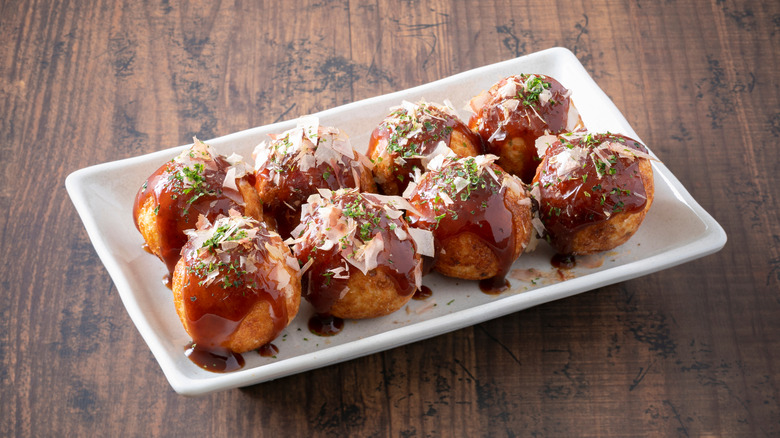How Takoyaki Came To Rule Japan's Street Food Scene
Japan's street food scene is one of the most exciting in the world. The iconic fish-shaped taiyaki, a sweet cake often filled with red bean paste, is a favorite for just about anyone walking by. Similarly, the savory cabbage, egg, and pork pancake, okonomiyaki, has been dominating the street food scene for years.
However, of the endless list of street-side snacks to try in the country, takoyaki just might be the ultimate ruler of the Japanese street food scene. According to Wanderlust, the dish incorporates fried batter balls made of "tiny pieces of octopus, tempura, green onions, and pickled ginger." Toppings include the aptly named takoyaki sauce (which Bokksu notes is akin to Worcestershire sauce), Japanese mayonnaise, and the enjoyable bonito (fish) flakes.
The first part of the name, "tako," translates to octopus and the second half, "yaki," alludes to the unique cooking method. The seafood bites are fried in small, takoyaki-shaped pans and flipped over — for adequate cooking — with toothpicks. The result is a golden, crunchy outside and soft inside, with a sweet and salty combination, making this a perfect dish for continued snacking.
However, just like most great foods, the process of creating the takoyaki we know and love today was one filled with trial and error.
Takoyaki had many former variations
Takoyaki was first created in Osaka in the mid-1930s, according to Bokksu. The site notes that the street vendor credited with its invention was named Tomekichi Endo.
The first few renditions, however, did not have the iconic roundness it does today. Rather, it was more box-shaped and flatter, as per Live Japan. However, although the shape was different, the ingredient list was pretty similar. Then, that rectangular version, called choboyaki, soon turned into rajioyaki. This time, according to the site, the version had a rounded shape, but the ingredients were different. Rajioyaki featured beef instead of octopus.
However, in 1935, the two iconic characteristics came together to form the rounded octopus balls we all know today. Bokksu notes that Endo was likely inspired to form this combination after taking notice of small round dumplings, called akashiyaki, that are local to the Hyōgo Prefecture.
Although takoyaki originated in Osaka, its popularity has spread across the entire nation, and can now be found on street corners in Tokyo or sidewalks in Kyoto. However, of the various regions takoyaki now populates, many different variations exist. For example, Bokksu notes that vendors in Tokyo will often add cabbage to the batter. Similarly, the sauces drizzled on top can change based on the region and time of year.
Regardless of the slight change in flavor profiles, takoyaki populates all kinds of festivals and celebrations across the country, and we're all better off because of it.

